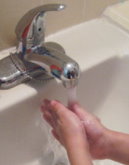|
|
Hand Washing
Overview
|
The hands serve as the conduit for the transmission
of microorganisms from person to person or from a
contaminated object to a person. Thus, the most effective
technique in preventing and controlling the spread of
infection is through hand washing. Clean hands with short
finger-nails, and no rings minimise the risk of
contamination. Although it is impossible to keep your bare
hands germ-free, it is your responsibility to limit the
transfer of bacteria, viruses and other microbes to the
person needing care or vice versa. |

When to Wash Your Hand?.
|
►
|
|
Before and
after rendering direct care.
|
|
|
► |
|
After each
contact with bloody or body fluids.
|
|
|
► |
|
After
contacting contaminated surfaces or objects.
|
|
|
► |
|
After you
remove your gloves.
|
|
|
►
|
|
|
► |
|
Tips on Basic Hand Washing.
|
►
|
|
Wet your hands
and lower arms thoroughly under running water.
|
|
|
► |
|
During
washing, keep the hands and forearms lower than the elbows.
This would ensure that water flows from the least to the
most contaminated area, rinsing microorganisms into the
sink.
|
|
|
► |
|
Apply soap
to all aspects of your hands,
including
the backs.
|
|
|
► |
|
Scrub all
surfaces for at least 15
seconds using friction. Interlace the fingers and rub the
palms and back of your hands with a circular motion at least
5 times each.
|
|
|
►
|
|
Pay
particular attention to the areas between the fingers and
under the nails where uninvited germs like to hang out.
|
|
|
► |
|
Rinse your hands
and wrists thoroughly, keeping hands down and elbows up.
This will prevent water dripping down your elbows.
|
|
|
► |
|
Dry well
with a clean or disposable towel from the fingers up to the
wrists and forearms. Drying from the cleanest area
(fingertips) to the least clean (forearms) is necessary to
avoid contamination.
|
|
|
► |
|
Use a
clean, dry paper towel to turn off the faucet to prevent
contaminating the cleansed hands.
|
|
|
►
|
|
If soap and
water are not available, antiseptic hand cleanser may be
used. The hands should then be washed with soap and water
as soon as possible.
|
|
|
|
|